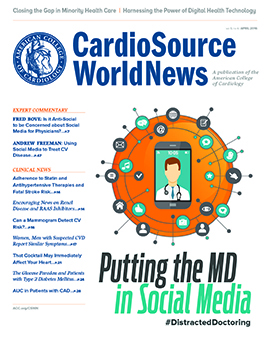Straight Talk: Using Social Media to Treat CV Disease
CardioSource WorldNews | Andrew M. Freeman, MD
Social media is here to stay. Be it your neighborhood chatting about issues, events, or sales on NextDoor.com; finding and keeping up with your friends on Facebook; meeting others to do common activities on Meetup.com; catching the latest news or research soundbite on Twitter; or participating in “Tweetups” at meetings like ACC’s Annual Scientific Session, social media is integrated into so many aspects of our lives.
When cell phones became easily available to the masses, they caused a revolution in how we do things and how we keep in touch. Similarly, social media is transforming how we share and receive information. Medicine, still relying on paper and faxes in much of the world, is always the slowest to catch up. But with more and more of our patients using social media every day for personal reasons, as well as to find health information or support networks, there is a need for us—the providers—to keep up. In a 2013 editorial in Circulation, Katherine C. Chretien, MD; Terry Kind, MD, MP, note that patients want to use social media for things like appointment or medication reminders, health information sharing, or answering general questions.
This is all well and good in theory, but how do we actually do this in ways that are meaningful and useful for our patients? While the answer to this question is constantly evolving, it does seem that using social media as means of educating patients, is the most logical place to start.
We know that an empowered and engaged patient does better clinically than one who is apathetic.
Some sites such as HealthTap, and leading institutions such as the Cleveland Clinic and Centura Health System, are offering online, personal consultations (akin to a secure videoconference session). Many of these consultations are simple fee-for-service and thus not easily and readily available to everyone. However, some of these sites allow the public to ask generic questions with physicians and other health care professionals providing general answers.
For the video-inclined, YouTube also allows comments, posting, and is social-media enabled. Many health care institutions are capturing expert, patient-focused video and presenting it via social media on YouTube. The ACC’s CardioSmart YouTube channel also offers a number of patient education videos around specific cardiovascular procedures or lifestyle choices.
One of the more innovative ways social media is being used is to challenge and empower patients to take tangible actions to improve health. For example, a number of services will send medication reminders via social media or text, or provide daily health tips related to things like smoking cessation, diet or exercise. Other programs such as Walk with a Doc (walkwithadoc.org) use social media outlets to promote and engage the public to use exercise as medicine to improve outcomes.
When it comes to virtual support, Facebook has a growing number of support groups for patients and their families facing similar disease processes. Many of these groups now host thousands of members and serve as a 24-hour support mechanism for patients in need. These online communities do wonders for disease outcomes, knowledge, and psychosocial support metrics. On the ACC front, the College hosts an annual “I am CardioSmart” contest via its CardioSmart Facebook page that recognizes people who have overcome challenges like heart attack, stroke, atrial fibrillation and congenital heart disease. The recent winners were announced during Heart Month in February, with the overall winner hosting a special session in the CardioSmart Patient Engagement Pavilion during ACC.16 in Chicago.
Twitter is also an important tool for sharing healthy living tips or the latest research with patients. The ACC has hosted several Twitter chats aimed at the broader public over the last few years on topics ranging from women and heart disease to heart disease prevention. These are great opportunities to share information in a succinct and interactive fashion.
So, in short, the bottom line is that it is time for you, me, and the medical community as a whole, to evolve and figure out the best, most efficient, and safest ways to provide extended “care” via social media. The tools are quite literally in our hands. Will you be a part or left out?
Andrew M. Freeman, MD, is a cardiologist and co-lead of the Nutrition Working Group for the ACC Prevention Council. Follow Dr. Freeman on Twitter (@heartcuredoc).

|
Read the full April issue of CardioSource WorldNews at ACC.org/CSWN |
Keywords: CardioSource WorldNews, Information Dissemination, Social Media
< Back to Listings
